
Dakshina Kannada district is located in the state of Karnataka in India, with its headquarters in the coastal city of Mangalore. The district covers an area nestled in between the Western Ghats to its east and the Arabian Sea to its west. Dakshina Kannada receives abundant rainfall during the Indian monsoon. It is bordered by Udupi district to the north, Chikmagalur district to the northeast, Hassan district to the east, Kodagu to the southeast and Kasaragod district of Kerala to the south. According to the 2011 census of India, Dakshina Kannada district had a population of 2,083,625. It is the only district in Karnataka state to have all modes of transport like road, rail, water and air due to the presence of a major hub, Mangalore. This financial district is also known as the Cradle of Indian banking.

The Tungabhadra River starts and flows through the state of Karnataka, India, during most of its course, then through Andhra Pradesh, and ultimately joins the Krishna River near Murvakonda in Andhra Pradesh.
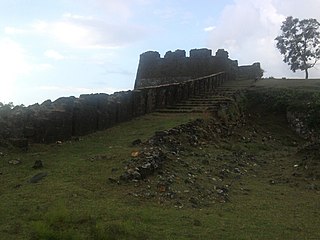
Nagara is a historic village in the Shivamogga district of the state of Karnataka, India. It is 17 kilometres (11 mi) from Hosanagara or 84 kilometres (52 mi) from Shivamogga. This was called Bidanur (Bidanoor) or Bidnur (Bidanoor) earlier during the 16th century, this was the last capital city of Nayakas of Keladi.
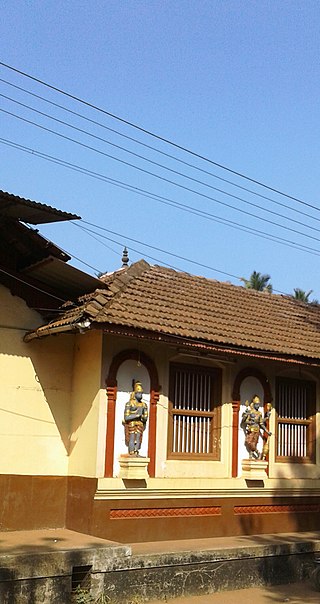
Bantwal is a suburb of Mangalore in Dakshina Kannada district, Karnataka, India, and the headquarters of Bantwal taluk. It is located 25 km (16 mi) East of Mangalore city center. BC Road-Kaikamba of Bantwal is one of the fastest developing areas in Dakshina Kannada district of Karnataka.
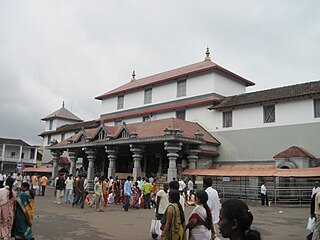
Dharmasthala is an Indian temple town on the banks of the Nethravathi River in the taluk of Belthangady of the Dakshina Kannada district in Karnataka, India.
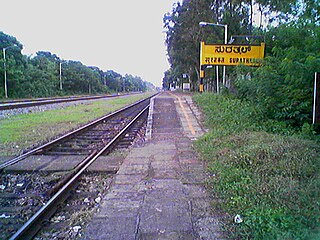
Surathkal is one of the major localities in the northern part of Mangalore taluk located on National Highway 66 in the Dakshina Kannada district, Karnataka state, India on the shore of Arabian sea. It is a municipality merged with Mangalore City Corporation. It lies between Gurupura (Phalguni) and Pavanje (Nandini) rivers. It is the northern suburb and can be considered as the northernmost area of Mangalore City until Mukka. Surathkal has a railway station on Konkan railway route which connects cities of Mumbai to Mangaluru. Surathkal is 8 km north of New Mangalore seaport, 4 km west of Mangalore Refinery and Petrochemicals Limited and 16 km west of Mangalore International Airport This region has developed educationally, industrially and commercially can be regarded as one of the crucial localities in Mangaluru and coastal Karnataka. The only NIT of Karnataka is situated here which is adjacent to the national highway NH 66. Mukka a popular name in Indian surfing is also situated close to Surathkal. Surathkal beach is well known for its cleanliness and well maintained like other beaches in Mangalore.
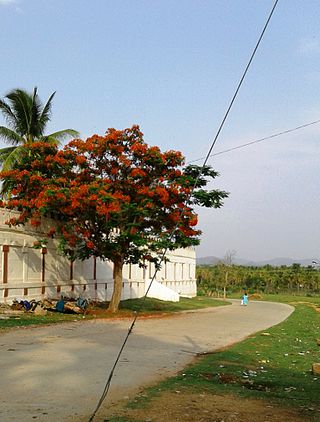
Arasikere is a city and taluka in the Hassan district in the state of Karnataka, India. It is the second largest city in Hassan district, demographically. Arsikere city municipal council consists of 35 wards. This region is known for its coconut production and is also called Kalpataru Nadu. Arsikere Junction is a major railway junction in the South Western Railway which links Mangalore and Mysore to North Karnataka and a central place for tourists who visit nearby places that do not have rail access, such as Belur, Halebidu and Shravanabelagola, Harnahalli, and Kodimata.

Nellitheertha Cave Temple in Nellitheertha, Karnataka, India is dedicated to the Indian deity Sri Somanatheshwara, or Shiva. The temple dates back to at least 1487 CE.

Sirsi, also spelled as Shirasi is a city in the Uttara Kannada district of Karnataka state in India. It was also known as "Kalyana Pattana" during the Sonda Dynasty. It is a tourist destination with evergreen forest and waterfalls and is also a commercial centre. The main businesses around the city are mostly subsistence and agriculture-based. Areca nut or betel nut, locally known as Adike, is the primary crop grown in the nearby villages, making it one of the major trading centres for areca nut. The region is also known for spices such as cardamom, pepper, betel leaves, and vanilla. The major food crop is paddy.
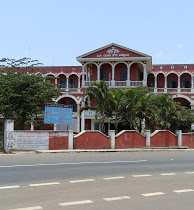
Chikkodi is a town, taluka and one of three Subdivisional headquarter, in the Belagavi district of Karnataka, India. Chikodi, Athani, Hukkeri, Raybag, Nipani and Kagwad are the taluks that come under Chikodi Subdivision. It is 75 kilometers from the city of Belgaum,53 kilometres from sangli.65 kilometers from Kolhapur, 51 kilometers from Miraj, 160 kilometers from Hubli, and 570 kilometers from the capital of Karnataka state, Bangalore. Chikodi has many district level offices but it is not designated as a district by the Government of Karnataka. It is one of the major cities that lie in the border between Karnataka and Maharashtra states.
Gadhinglaj ([ɡəɖᵊɦiŋɡləd͡z]) is a city in India in the Kolhapur district in the southwest corner of the state of Maharashtra, India. It is located on the banks of the river Hiranyakeshi. It is the Taluka (Tehsil) headquarters of Gadhinglaj Taluka and a subdivision headquarters of the Gadhinglaj Subdivision of the Kolhapur District. It is governed by a municipal council. The rapidly growing city is the third largest in the Kolhapur District, with population of more than 50,000. Places to visit include Samagad fort, temples and beautiful weather.
Talapady is a village near Mangaluru city in Ullal taluk of Dakshina Kannada district of Karnataka state in India. Talapady borders the states of Karnataka and Kerala. National Highway 66 passes through Talapady which is 14 km (9 mi) south of Mangalore city. The Karnataka-Kerala checkpost border is situated at Talapady. Another village Thalapady, Kasargod which is situated near Talapady in Manjeswar crossing Kerala border.
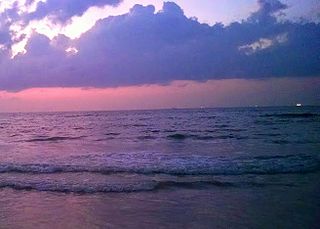
Panambur is one of the localities in Mangalore famous as a tourist spot. It is also a major industrial area and the site of Karnataka's main port, New Mangalore Port. Major industrial plants, such as Mangalore Chemicals & Fertilizers and KIOCL, are located here. Panambur lies north of the Gurupura River's confluence with the Arabian Sea about 10 kilometres (6.2 mi) north of Mangalore city centre, Dakshina Kannada district of Karnataka state, India. Panambur along with Baikampady and Jokatte are the main industrial areas of Mangalore and one of the major industrial areas of Karnataka.

Venur or Vēnooru is a small village on the banks of the Phalguni river in Belthangady Taluk, Dakshina Kannada district of Karnataka, India. It was once the seat of Jainism and the capital of the Ajila Dynasty. It is on the Dharmasthala-Moodabidri-Karkala route on the coastal religious circuit in the Karnataka State of India.
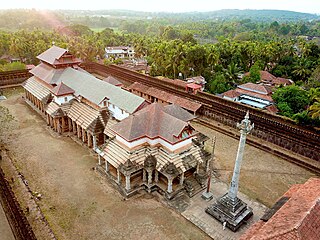
Moodubidire is a town and taluk in Dakshina Kannada district. It lies 34 km northeast of the district headquarters, Mangalore, in Karnataka, India.
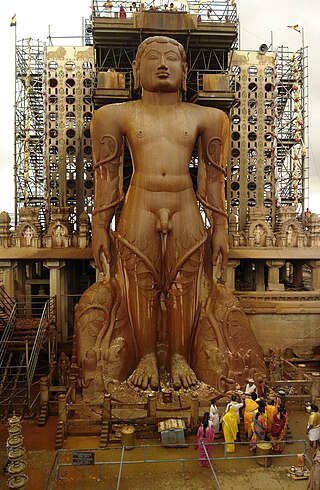
Karnataka, the sixth largest state in India, was ranked as the third most popular state in the country for tourism in 2014. It is home to 507 of the 3600 centrally protected monuments in India, second only to Uttar Pradesh. The State Directorate of Archaeology and Museums protects an additional 752 monuments and another 25,000 monuments are yet to receive protection.
Kaikamba also known as Gurupura Kaikamba is a suburban town of Mangalore, Dakshina Kannada District, Karnataka State, west coast of India. Kaikamba lies between Moodabidri and Mangalore city in Dakshina Kannada district. This town lies on Mangalore – Moodabidri Highway National Highway 169. Kaikamba is 12 km away from Mangalore city. Also 5 to 6 km away from Bajpe town. where Mangalore International Airport is located. Distance from Airport to Kaikamba is just 8 km. Population of Kaikamba is about 15,325 as per 2009 census. Parts of Kaikamba are administered by Paduperar Panchayat, Kandavara Panchayat and Ganjimutt Panchayat. Efforts are being made to include this town into Mangalore city corporation limits by the year 2015. The proposed KIADB Software export promotional park is 3 km away.

The Gurupura River is a river in the Karnataka state of India. It originates in the Western Ghats and is a distributary of the Netravati River, which empties into the Arabian Sea, south of Mangalore. It gets its name from the town Gurupura, situated near Mangalore. The New Mangalore Port and Mangalore Chemicals and Fertilizers are situated on its northern banks.

Karkala is a town and the headquarters of eponymous Karkala taluk in the Udupi district of Karnataka state in India. It lies near the foothills of the Western Ghats, Karkala has a number of natural and historical landmarks, and is a major tourist and transit destination due to its strategic location along the way to Hebri, Sringeri, Kalasa, Horanadu, Udupi, Kollur, Subrahmanya and Dharmasthala.

Polali Rajarajeshwari Temple is a temple located in Polali, Dakshina Kannada district in Karnataka. The primary deity of the temple is Shri Rajarajeshwari. The temple was constructed in the 8th century AD by King Suratha and has been developed by many dynasties which ruled over the region. The idol of Sri Rajarajeshwari, another name/form of the divine Goddess Sri Lalita Tripurasundari, is completely moulded from clay with special medicinal properties. The temple portrays Hindu architecture with roofs adorned with wooden carvings of gods and copper plates. Daily and special poojas are conducted in the temple under the auspices of the head priests K Rama Bhat, Madhava Bhat, Parameshwara Bhat and Narayan Bhat .Annual festivals are held in the temple with much fanfare. Polali Chendu festival is an important festive event where football is played to represent the fight of good over evil. The Chendu festival is followed by the annual festival in March, which lasts for a month and is attended by people from all over the world.Tipu Sultan was an admirer of Polali Chendu and had a platform built for him to watch the game. It is called Sultan Katte even to this day.

















